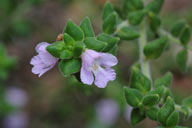In Flower This Week
A news sheet prepared by a Gardens' volunteer.
Numbers before each plant refer to temporary IFTW labels in the gardens.
Numbers in square brackets [ ] refer to garden bed Sections. Plants in flower are in bold type.
View past issues of 'In Flower This Week'.
1 April 2015
Prostanthera densa click for larger image |
Today we will walk from the Visitor Information Centre (VIC) towards the Sydney Region Gully.
- Swainsona formosa [Section 221] is on the right-hand side in a pot as you leave the VIC. Commonly known as Sturt’s Desert Pea it has pale green leaves and bright red pea flowers with shiny black centres or bosses.
- Also in a pot on the right is Prostanthera densa [Section 221], or Villous Mintbush, a stiff, angular plant with pale green leaves and mauve flowers with orange markings. This plant, listed as vulnerable, is native to coastal New South Wales north and south of Sydney.
- Bear left up the hill behind the café and then bear right to follow the road behind the depot. On your left is Grevillea bipinnatifida ‘Jingle Bells’ [Section 124]. It has deeply divided stiff, prickly foliage and many trusses of pink and orange flowers. Bear left up the hill and take the first right.
- Just before you cross the paved road directly ahead and move onto the dirt path, on your right is Callistemon subulatus [Section 10]. It has bright red brush-like flowers and a low spreading habit. It is native to the states of New South Wales and Victoria where it grows along the banks of watercourses.
- Continue on the dirt path to see Callistemon citrinus [Section 9] on your left, a long-flowering shrub with bright red brush-like flowers. The Crimson Bottlebrush is a popular garden plant which can grow well in wet conditions. It is found naturally in south eastern Australia.
- On your left is Banksia cunninghamii [Section 28] with dull gold cones with dark red styles. This plant grows along the east coast of Australia.
- Further on your left is Banksia paludosa [Section 28], with plain gold cones. It grows naturally in the open forests and woodlands of central and southeastern New South Wales, with an outlying population on the north coast near Kempsey.
- Also on your left is Lambertia formosa [Section 28], or Mountain Devil, with red flowers with long styles and bracts. It gets its common name from the horned woody seed follicles, which were used to make small devil-figures. It is endemic to the coast and ranges of New South Wales.
- As you turn left up the hill on the paved road on your left is Banksia integrifolia subsp. compar [Section 28], or Coast Banksia, a small tree with long yellow cones and dark green leaves with silver backs. This tree is found naturally along the east coast of Queensland.
- Telopea mongaensis [Section 28], or Monga Waratah on your left, has bright red flowerheads held upright above an open bush of dull green foliage. It grows at high altitude in south-eastern New South Wales.
- On the right is Correa ‘Canberra Bells’ [Section 112], a small neat bush with red and white bell flowers. It was chosen to commemorate Canberra’s centenary in 2013.
- Banksia aemula [Section 191g], or Wallum Banksia, on your right, is a small gnarled tree with knobby bark and large squat green cones. This plant can be found in Queensland and New South Wales, from Bundaberg to Sydney, in coastal heath on sandy soils.
- Banksia ericifolia [Section 191g] on the right has squat yellow cones with rusty red styles. It grows naturally on the coast and ranges of New South Wales.
- Also on your right is Banksia spinulosa var. cunninghamii [Section 191g], a small tree with dull gold flowers with black styles. It is native to the three eastern states extending along the coast from Victoria to Cairns
- Behind the Sydney Region Gully sign on your right is Melaleuca thymifolia [Section 191l], a small bush with close blue-green foliage and purple ‘claw’ flowers.
Rosalind Walcott
![Director of National Parks [logo]](../../../../images/dnp_90px.gif)







